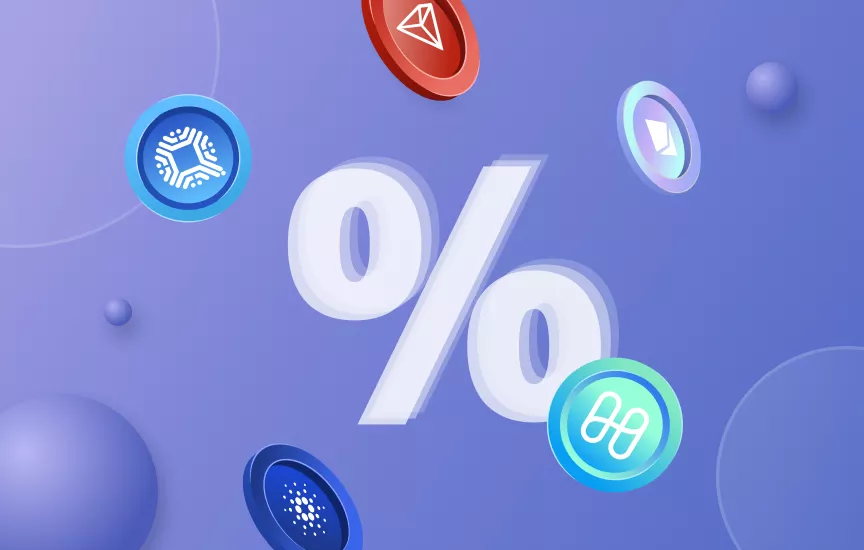As the world embraces digital currencies, more people seek ways to earn passive income from their crypto holdings. One of the primary methods investors use is by staking their assets and earning interest, or what’s known as APY. But what exactly is APY in the crypto world, and how is it calculated?
Whether you’re new to crypto or an experienced investor, understanding, APY is critical to maximizing your earnings potential. So, in this article, we’ll dive deep into the meaning and calculation of APY in crypto.
Key Takeaways
- APY stands for Annual Percentage Yield and measures the annual rate of return on investments that a user can earn on their cryptocurrency holdings.
- APY is calculated based on the compounding interest the user earns for one year.
- Compounding interest is earned on the initial investment and the accumulated interest.
- APY can vary based on the platform where the user holds their cryptocurrency.
What Is APY?
APY refers to the interest or yield investors can earn by staking or holding their crypto assets in certain protocols or platforms, considering the compound interest. It is typically associated with decentralized finance (DeFi) platforms, which use smart contracts to automate financial transactions and provide various financial services like lending, borrowing, and yield farming. These platforms enable users to earn passive income by staking or locking up their cryptocurrencies in liquidity pools, facilitating trades, and providing liquidity. The APY earned on these investments can vary greatly depending on the platform, the type of cryptocurrency, and market conditions.
For example, when staking your ETH on a platform like Guarda Wallet, the platform shows you a 3% APY, the estimated return you will receive over time.
What Is Compound Interest?
Compound interest refers to the process of earning interest on the interest earned on cryptocurrency investment. Compound interest is earned on both the initial deposit and the interest gained on that deposit, as opposed to simple interest, which is earned only on the initial investment.
In other words, when you invest in a cryptocurrency that offers compound interest, the interest you earn is added to the original investment. The interest is then calculated based on the new, larger amount. This process is repeated over time, resulting in exponential investment growth through the power of compounding.
How to Calculate APY in Crypto
Let’s say the interest rate offered by the platform for staking ADA is 5% APY. When you stake 1000 ADA, you will receive a certain amount of ADA as a reward yearly. Calculating these rewards or interest accumulated is straightforward; you can use a calculator or the formula below. The formula to calculate APY is:
APY = (1 + r/n)ⁿ - 1
Where: r is the annual interest rate n is the number of times interest is compounded per year
Using the APY above, 5% (0.05), and if we assume daily compounding (n=365), the APY calculation would be:
APY = (1 + 0.05/365)^365 - 1 APY = 0.050972 or 5.0972%
Earn Up to 25% APY Staking Your Favorite Assets
Crypto Staking APY
Crypto staking APY is essential when deciding to stake your digital assets. By understanding how APY works and the factors that affect it, you can make more informed decisions and potentially maximize your staking rewards. Always do thorough research and consider the risks involved in any staking opportunity. So, what are the factors that affect APY? 1. The cryptocurrency being staked: Different coins have different staking rewards and requirements, which can impact the APY. 2. The staking duration: Some platforms offer higher APYs for extended staking periods, providing the network more stability. 3. Network conditions: The APY can vary depending on the total amount staked in the network and the demand for staking.
APY and APR - What Is the Difference?
APY (Annual Percentage Yield) and APR (Annual Percentage Rate) are terms related to interest rates but have distinct meanings and are often used interchangeably. APY represents the total amount of interest earned on staking in one year, taking into account the compound interest or the interest on interest. APY is generally higher than APR because it includes the compounded interest, which increases the yield over time.
APR, on the other hand, represents the annual interest rate charged on an investment without taking into account the compounding effect. It is a simple interest rate that doesn’t consider the interest earned or paid on interest.
Conclusion
Understanding APY not only helps you assess the potential returns on your investment but also helps you gauge the level of risk associated with the investment. In a rapidly evolving market like cryptocurrency, it is crucial to stay informed about APY rates and other key metrics. Therefore, it is important to approach your investments with a sound strategy and a well-rounded understanding of the market.
With the knowledge of APY, you can make informed decisions that can potentially yield tremendous gains while minimizing risk.
Create a Crypto Wallet on Guarda
Disclaimer: The opinions expressed in this article are for general informational purposes only. They are not intended to provide specific financial or investment advice. Guarda’s editorial team reminds you of the risk of speculation in all financial markets. All financial activities carried out by you are made at your own risk.
FAQ
1. What is a good APY percentage?
A good APY percentage depends on the specific investment, the amount of the initial investment, and the platform used. Generally, higher APY percentages are more attractive but may come with higher risks.
2. What does 5.00% APY mean?
A 5% APY means that, over the course of a year, your investment would grow by 5% or 0.05 due to interest, taking compounding interest into account.
3. How to calculate APY in Crypto?
To calculate APY in crypto, you need to know the interest rate and compounding frequency, then apply the formula APY = (1 + r/n)^n - 1, where r is the interest rate, and n is the number of compounding periods per year.



